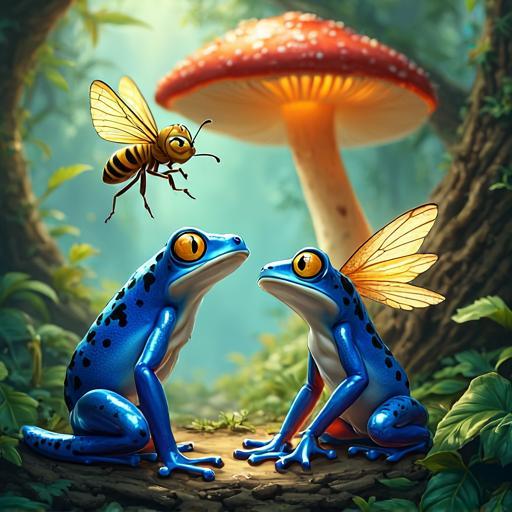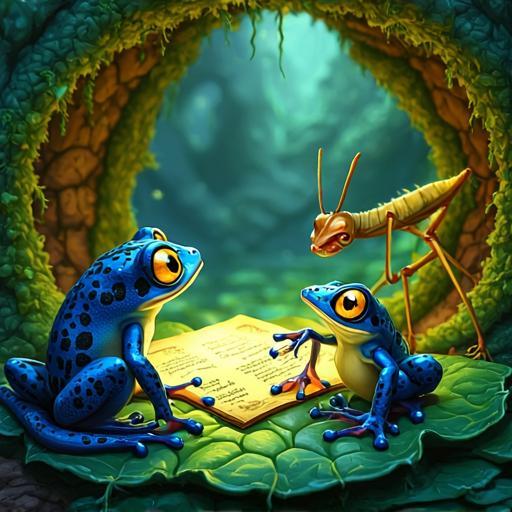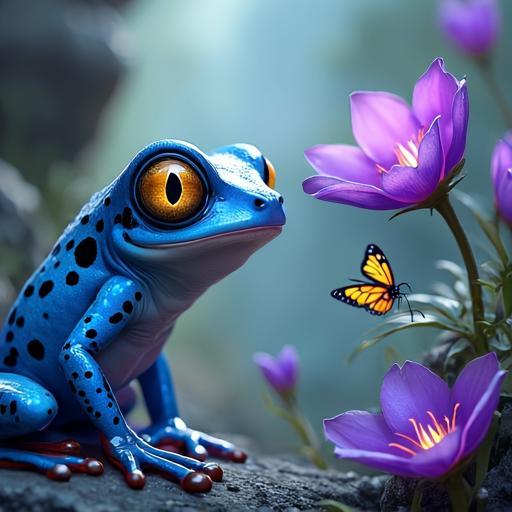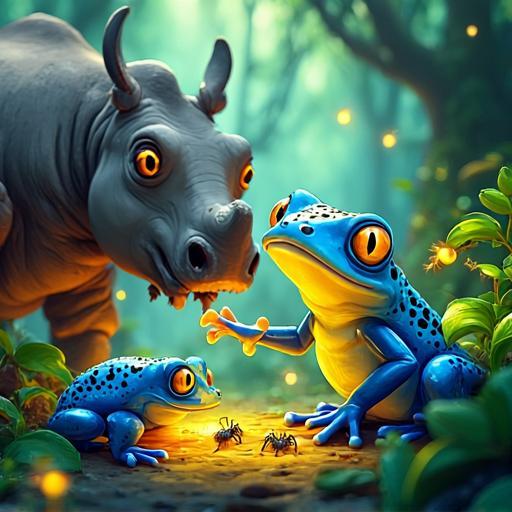Kael and the Heart-Light of Chrysalis
A frog helps an insect city solve an environmental crisis.
The Fading Light

Kael, a Poison Dart Frog, was an unusual sight in Chrysalis. Most rainforest animals kept their distance from the city woven into the giant Kapok tree, but the insects trusted Kael's keen mind. Today, that trust was a heavy weight. The Queen Bee led him to the city's core, where the Heart-Light, a colossal bioluminescent fungus, pulsed with a weak, sickly glow. "Our power fades," she buzzed, her voice tight with worry. "The hum of our city is falling silent." Kael circled the fungus, his golden eyes scanning every detail. He noticed a fine, grey dust coating the nearby leaves—something that didn't belong in this vibrant world of rainforest animals and plants. It was a clue.
The Archives of the Ants

"We must consult the archives," declared a wise old Stick Insect, guiding Kael into the Great Library of the Ants. Here, history wasn't in books, but etched into thousands of preserved leaves. "Many rainforest animals facts are stored here," the elder whispered. They searched for records of a failing Heart-Light. Kael found a complex leaf that looked like a kind of ancient 'insects worksheet', a diagnostic tool from a forgotten age. Deciphering the patterns, he learned about invasive pollens. "This dust," Kael realized, "It's a poison." The archives also held fascinating scrolls about insects in Korea, noting how some, like the *Parnassius bremeri* butterfly, were incredibly specialized. The Korean word for insects, '곤충' (gonchung), was written beside a drawing. This was no accident; this was a deliberate act or a terrible ecological mistake.
The Moral Dilemma

Their investigation led them to the city's edge. There, a cluster of beautiful, yet alien, purple flowers bloomed, leaking the grey pollen-dust. The source. But a team of soldier beetles, from the order Coleoptera, halted. The flowers were covered in caterpillars and dazzling butterflies, their wings like stained glass. "It's the *Parnassius bremeri*," the Stick Insect breathed, referencing the scroll. "A rare species. These flowers are their only food. If we destroy the plants to save our city, we extinguish them." Kael felt a pang of conflict. Saving his friends meant destroying these beautiful creatures. It was a heavy moral choice, a true test of leadership and responsibility.
The Symbiotic Solution

Kael looked from the worried beetles to the innocent butterflies. Destruction was not the answer. "We won't destroy them," he announced, his voice clear and firm. "We will move them." His plan required intricate teamwork. He, one of the most thoughtful rainforest animals for kids to learn about, directed the operation. Strong soldier beetles carefully clipped leaves bearing the caterpillars. Spiders wove soft, silk cradles to transport the delicate chrysalises. Fireflies created a glowing pathway to a grove of native host plants Kael knew could sustain the butterflies. It was a slow, painstaking process, a beautiful display of different insects using their skills for a common, compassionate goal. As the last larva was moved, the city's hum began to return, stronger than before, and a new colony of butterflies awoke in a safe home.